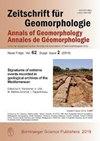黎巴嫩中部黎巴嫩山Kanaan、Kassarat和Jeita岩溶系统溶洞水平控制
IF 1.3
3区 地球科学
Q3 GEOGRAPHY, PHYSICAL
引用次数: 14
摘要
黎巴嫩山是一个多山的地中海喀斯特山脊,由海拔3088米的高原和深谷组成。河流排水系统在一个陡峭的坡度上运行,在不到30公里的距离内到达地中海沿岸。在黎巴嫩山中部,Antelias和Kalb山谷下游有Kanaan洞穴(160米)、Kassarat洞穴(4.6公里)和Jeita洞穴(10.05公里),其地下河流与位于白垩纪和侏罗纪喀斯特含水层接触处的喀斯特泉水相连。因此,该地区包括一个侏罗纪蓄水层,所有研究的洞穴水平都在一定的高度发育。通过洞穴学和地貌调查进行的地貌学研究,以及对洞穴沉积物的分析,形成了喀斯特系统的第一个演化框架。一些特征表明,安特利亚斯和卡尔布山谷的喀斯特都经历了长期和多阶段的演化。水平溶洞在海拔高度60 ~ 160 m之间发育,构成了陡倾构造(黎巴嫩山西褶皱)中的地下水洞。这些洞穴水平是一个古老系统的一部分,该系统在地下水位附近发展,由水层的位置控制,与过去河流网络的基准面相对应。在海拔90 m以上的残洞段中记录了基准面洞发育的一个重要阶段。90 ~ 160 m之间的洞穴发育特征是在基准面上升过程中发生共生或“逐升侵蚀”过程的潜水环境中发育的。Kassarat洞和Jeita洞在60 ~ 70 m处有明显的附生特征。典型的形态特征,如水平的溶液通道和溶液缺口表明一个阶段的静止的基础水平。地下水位从90 m以上的共生上升到90 m以下的连续下降,并在70 ~ 60 m处暂时静止,其演变与河流基准面演变有关。根据90 ~ 160 m和60 ~ 70 m的洞穴层位U/Th定年及其与低梯度地表高度的关系,讨论了岩溶系统演化的初步年代学约束。90 ~ 160米的洞穴高度可能与上新世地中海海侵时期河口的一次水位上升有关。上层洞穴水位(90-160米和60-70米)的消失是与河流切割有关的地下水位持续下降的结果。地下水位下降到90 m以下,主要与更新世高动力背景下(黎巴嫩山隆起)的水侵断有关。本文章由计算机程序翻译,如有差异,请以英文原文为准。
Control of cave levels in Kanaan, Kassarat and Jeita karst systems (Central Mount Lebanon, Lebanon)
Mount Lebanon is a mountainous Mediterranean karst ridge, consisting of high plateaus reaching 3,088 m altitude and entrenched by deep valleys. Fluvial drainage systems run on a steep gradient and reach the Mediterranean Sea coast in less than 30 km distance. In Central Mount Lebanon, the downstream parts of Antelias and Kalb valleys host the Kanaan cave (160 m), the Kassarat cave (4.6 km) and the Jeita cave (10.05 km), whose subterranean rivers are connected to the karst springs located close to the contact between the Cretaceous aquidude and the Jurassic karst aquifer. The area thus comprises a dammed Jurassic aquifer in which all the studied cave levels developed at certain altitudes. A geomorphological study performed by speleological and geomorphological surveys and completed by analyses of cave sediments allowed the formulation of a first evolutionary framework of the karst system. Several features suggest a long-term and multi-stage evolution of the karst in both Antelias and Kalb valleys. The horizontal caves develop between 60 and 160 m a.s.l. and constitute water table caves in a steeply dipping structure (Mount Lebanon's western fold). These cave levels are part of an ancient system that developed near the water table controlled by the position of the aquiclude and correspond to the base level of a past fluvial network. An important phase of base level cave development is documented in the relict passages above 90 m a.s.l. Speleogenetic features between 90 and 160 m developed in a phreatic environment where paragenesis or "per ascensum erosion" processes occurred during base level rise. Epiphreatic features were identified at 60-70 m in Kassarat and Jeita caves. Typical morphological features such as horizontal solution passages and solution notches suggest a phase of stillstand of the base-level. The evolution of the water table level from a paragenetic rise above 90 m to a continuous lowering below 90 m and with a temporary stillstand phase at 70-60 m, is related to the fluvial base-level evolution. Preliminar chronological constraints for the evolution of the karst system are discussed based on U/Th dating of speleothems and cave levels (90-160 and 60-70 m) and their relationship with the altitude of the low-gradient surfaces. The cave levels between 90 and 160 m are related to a water table rise that caused an alluviation process at the river's mouth probably during the Pliocene transgression phase of the Mediterranean Sea (PHS). Abandoning of the upper cave levels (90-160 and 60-70 m) is the result of a continuous lowering of the water table related to fluvial incision. The lowering of the water table level below 90 m is mainly related to the fluvial incision of the acquiclude in a high geodynamic context (Mount Lebanon uplift) during the Pleistocene.
求助全文
通过发布文献求助,成功后即可免费获取论文全文。
去求助
来源期刊

Zeitschrift fur Geomorphologie
地学-地球科学综合
CiteScore
2.00
自引率
4.50%
发文量
14
审稿时长
6-12 weeks
期刊介绍:
Zeitschrift für Geomorphologie main volume is a peer-reviewed international journal presenting original contributions of high scientific standard from all fields of geomorphology, encompassing basic research and applied studies. Zeitschrift für Geomorphologie (ZfG) invites the submission of original papers from the entire field of geomorphological research, both applied and theoretical. Authors are encouraged to submit their papers to the editor-in-chief. Please peruse the instructions to authors (PDF) before submitting your paper.
 求助内容:
求助内容: 应助结果提醒方式:
应助结果提醒方式:


